Contradusta lapillus Poppe, Tagaro & Groh, 2013 voir Contradusta walkeri walkeri
+14
Guy-gerard
Michel Bargoin
Vinot William
Rhum3389
jean marc jubert
LETERRIER Franck
Guy Bréchon †
HENRI.13090
Clem4102
Alexis Moisson-shellalex
Whiteshark
PLF
Zonatus
Bernard Clavé †
18 participants
Page 1 sur 2 • 1, 2 

 Bernard Clavé †Modérateur
Bernard Clavé †Modérateur
- Messages : 7265
Date d'inscription : 28/06/2011
Age : 82
Localisation : Gironde
 Contradusta lapillus Poppe, Tagaro & Groh, 2013 voir Contradusta walkeri walkeri
Contradusta lapillus Poppe, Tagaro & Groh, 2013 voir Contradusta walkeri walkeri
Jeu 18 Avr 2013 - 13:47
Une nouvelle espèce vient de faire son apparition au WoRMS :
Cypraea lapillus (Contradusta) - Poppe, Tagaro & Groh, 2013
Quelqu'un a t'il des infos sur cette espèce ?
Bernard
Cypraea lapillus (Contradusta) - Poppe, Tagaro & Groh, 2013
Quelqu'un a t'il des infos sur cette espèce ?
Bernard
_________________
Je pense ce que je dis, je dis ce que je fais et je fais ce que je dis...... Et qu'importe le "Qu'en dira t'on".......



Nanard33
 Re: Contradusta lapillus Poppe, Tagaro & Groh, 2013 voir Contradusta walkeri walkeri
Re: Contradusta lapillus Poppe, Tagaro & Groh, 2013 voir Contradusta walkeri walkeri
Jeu 18 Avr 2013 - 16:43
Elle est décrite dans le dernier Visaya.
Pour certains il ne s'agirait que d'une forme pâle de Cyp. walkeri mais les auteurs assurent que l'animal est différent.
Pour certains il ne s'agirait que d'une forme pâle de Cyp. walkeri mais les auteurs assurent que l'animal est différent.
 PLFAssidu
PLFAssidu
- Messages : 3037
Date d'inscription : 25/04/2010
Age : 69
Localisation : 1 rue de la Tuilerie 55500 Foucheres aux Bois
 Re: Contradusta lapillus Poppe, Tagaro & Groh, 2013 voir Contradusta walkeri walkeri
Re: Contradusta lapillus Poppe, Tagaro & Groh, 2013 voir Contradusta walkeri walkeri
Sam 20 Avr 2013 - 19:19

Contradusta lapillus - Poppe, Tagaro & Groh, 2013
Spécimen de 21.5 mm, chaluté par 100 à 150 mètres - Surigao del Sur, Philippines
(image du spécimen actuellement aux enchères sur Shell Auction Net)
 Re: Contradusta lapillus Poppe, Tagaro & Groh, 2013 voir Contradusta walkeri walkeri
Re: Contradusta lapillus Poppe, Tagaro & Groh, 2013 voir Contradusta walkeri walkeri
Dim 21 Avr 2013 - 0:57
Ce ne sont que des walkeri... et si je regarde bien, je dois en avoir quelques dizaines en stock de similaires... localité différente ou forme de profondeur ??? à voir... mais bon, de là à en faire une nouvelle espèce c'est abusé à mon sens... enfin... avec l'ADN il semblerait que chaque spécimen est une espèce a part entière de nos jours... on n’arrête plus le progrès... LOL
En tout cas, il est toujours intéressant de voir qui décrit... et quoi de mieux que toutes ces nouvelles "pseudo-espèces" pour pouvoir refourguer les fonds de tiroirs...
En tout cas, il est toujours intéressant de voir qui décrit... et quoi de mieux que toutes ces nouvelles "pseudo-espèces" pour pouvoir refourguer les fonds de tiroirs...
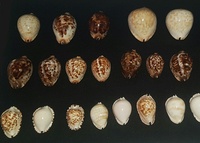 Alexis Moisson-shellalexAssidu
Alexis Moisson-shellalexAssidu
- Messages : 3060
Date d'inscription : 25/10/2010
Age : 27
Localisation : Caen
 Re: Contradusta lapillus Poppe, Tagaro & Groh, 2013 voir Contradusta walkeri walkeri
Re: Contradusta lapillus Poppe, Tagaro & Groh, 2013 voir Contradusta walkeri walkeri
Dim 21 Avr 2013 - 9:31
Oui mais à décrire tout à partir de l'ADN c'est la porte ouverte au arnaques car nous collectionneurs n'avons pas la possibilité de faire nos propres études adn ...
_________________
Zoila venez à moi !!!!

 Bernard Clavé †Modérateur
Bernard Clavé †Modérateur
- Messages : 7265
Date d'inscription : 28/06/2011
Age : 82
Localisation : Gironde
 Re: Contradusta lapillus Poppe, Tagaro & Groh, 2013 voir Contradusta walkeri walkeri
Re: Contradusta lapillus Poppe, Tagaro & Groh, 2013 voir Contradusta walkeri walkeri
Ven 26 Avr 2013 - 8:20
Voici un message reçu de Conchology,Inc :
This was as such already centuries ago, when Linnaeus described the fake cowry "Cypraea amethystina" and it was as such in the golden time of shell collecting when the king of shell dealers of the 20th century, Gino Raybaudi, was trapped with the "teramachii splendida" in 1995. It is still so today. We got lured in by local dealers and our trust was shamefully misused. We acquired 10 faked Contradusta lapillus without knowing it. Fortunately, the real C. lapillus exists, and now over a hundred pieces have been found.

"Contradusta lapillus Poppe, Tagaro & Groh, 2013". "The real one"
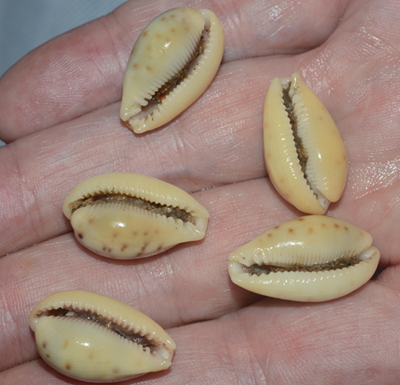
Freshly caught two days before this photograph, preserved in alcohol.
Things went as follows: our company sponsored some fisherman working deep waters offshore Surigao, by purchasing at a handsome price their catches. To our big surprise they fished a white cowry, close to - but different from - what is called Contradusta walkeri. We offered a few pieces to selected Cowry collectors and auctioned one shell, which went for about 400 Euro to a Belgian collector.
After a close examination, and as material slowly poured in, we decided to describe the cowry. While researching information, we stated that this cowry is found about everywhere in the Visaya's when one goes 100 m deep. Sheila P. Tagaro even photographed a specimen dredged in Panglao in 2004 during her assignment in the now famous and legendary "Panglao expedition 2004".
So, things went very well and Visaya appeared with the description of "Contradusta lapillus Poppe, Tagaro & Groh, 2013", in time for the Paris shell show. During that shell show, Felix Lorenz acquired about 30 pieces from a well-known French dealer also living in the Philippines. While scrutinizing his material, Felix came to the conclusion that the materials were fake C. walkeri. He tested out heating and could produce the same shells.
At the same time, shells appeared everywhere, especially also on a popular auction site. A telephone call to the Belgian collector learned me that he wanted to describe the new item: he could acquire several more, directly from Philippine dealers.
I was shocked and an investigation was highly needed. So, we called and interrogated many fishermen and middlemen. The truth became apparent very quickly: after our auction, local dealers often get the photographs of our auction shells from Europe and America with questions from collectors "to purchase" these items cheaper. A quite naïve action, as most of our auction pieces are difficult to find and even very often they are unique.
The son of a famous local dealer was immediately focused and went to the local "shell doctor" with pieces of walkeri which were then heated in "cooking oil", so the color turned pale and resembles the C. lapillus.

A C. walkeri - cooked. The Fake "lapillus".
The French dealer acquired about 20 of these fakes, Conchology, 10 pieces. All offerings were made drop-wise of course. Many fakes went abroad. The shells offered by one dealer on this auction site are another story. One of the fisherman, paid indirectly by our company, took the shells out of the dredged material when there was no supervision. He then sold these to one of the dealers active on the auction site.
It took us a trip to Surigao to find this out. We also obtained there a dozen of C. lapillus which we now have in alcohol and of which some will be used for molecular research, also in order to see differences with C. walkeri.
According to Felix Lorenz, the correct genus should be "Ficadusta" and in the worst case the new name can be used for what is now called the classic Philippine walkeri (not the surabajensis).
Conchology, Inc. sold 4 of the fake cowries. They are replaced with genuine ones of course. The difference between the fakes and the real C. lapillus is hardly visible. Real lapillus are usually smaller than the fakes, usually a little more slender and usually the pattern typical for "surabajensis" is less visible. The color is most often more yellowish. In the batch of shells, which F. Lorenz returned to the French dealer, there were 10 genuine shells. This was confirmed to me by the fisherman. It may explain why some of his shells lighted up differently under UV. The few shells that I've seen on the auction site (only 5) were genuine. But this morning I met the "shell doctor" who got a truly big smile: faking shells is definitely not yet finished.

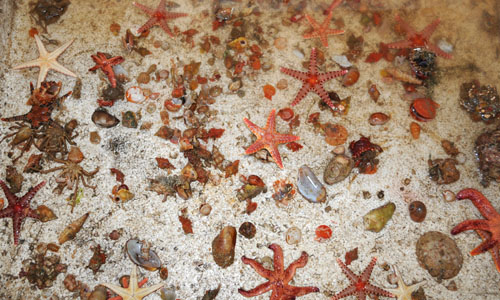
Sheila P. Tagaro with our fishermen in Surigao. I enlarge the two day catch, as for sure you are very curious to see what's in the box !
So far this very frustrating but fascinating story about fakes, one more chapter in the history of shell collecting.
Bernard
This was as such already centuries ago, when Linnaeus described the fake cowry "Cypraea amethystina" and it was as such in the golden time of shell collecting when the king of shell dealers of the 20th century, Gino Raybaudi, was trapped with the "teramachii splendida" in 1995. It is still so today. We got lured in by local dealers and our trust was shamefully misused. We acquired 10 faked Contradusta lapillus without knowing it. Fortunately, the real C. lapillus exists, and now over a hundred pieces have been found.

"Contradusta lapillus Poppe, Tagaro & Groh, 2013". "The real one"

Freshly caught two days before this photograph, preserved in alcohol.
Things went as follows: our company sponsored some fisherman working deep waters offshore Surigao, by purchasing at a handsome price their catches. To our big surprise they fished a white cowry, close to - but different from - what is called Contradusta walkeri. We offered a few pieces to selected Cowry collectors and auctioned one shell, which went for about 400 Euro to a Belgian collector.
After a close examination, and as material slowly poured in, we decided to describe the cowry. While researching information, we stated that this cowry is found about everywhere in the Visaya's when one goes 100 m deep. Sheila P. Tagaro even photographed a specimen dredged in Panglao in 2004 during her assignment in the now famous and legendary "Panglao expedition 2004".
So, things went very well and Visaya appeared with the description of "Contradusta lapillus Poppe, Tagaro & Groh, 2013", in time for the Paris shell show. During that shell show, Felix Lorenz acquired about 30 pieces from a well-known French dealer also living in the Philippines. While scrutinizing his material, Felix came to the conclusion that the materials were fake C. walkeri. He tested out heating and could produce the same shells.
At the same time, shells appeared everywhere, especially also on a popular auction site. A telephone call to the Belgian collector learned me that he wanted to describe the new item: he could acquire several more, directly from Philippine dealers.
I was shocked and an investigation was highly needed. So, we called and interrogated many fishermen and middlemen. The truth became apparent very quickly: after our auction, local dealers often get the photographs of our auction shells from Europe and America with questions from collectors "to purchase" these items cheaper. A quite naïve action, as most of our auction pieces are difficult to find and even very often they are unique.
The son of a famous local dealer was immediately focused and went to the local "shell doctor" with pieces of walkeri which were then heated in "cooking oil", so the color turned pale and resembles the C. lapillus.

A C. walkeri - cooked. The Fake "lapillus".
The French dealer acquired about 20 of these fakes, Conchology, 10 pieces. All offerings were made drop-wise of course. Many fakes went abroad. The shells offered by one dealer on this auction site are another story. One of the fisherman, paid indirectly by our company, took the shells out of the dredged material when there was no supervision. He then sold these to one of the dealers active on the auction site.
It took us a trip to Surigao to find this out. We also obtained there a dozen of C. lapillus which we now have in alcohol and of which some will be used for molecular research, also in order to see differences with C. walkeri.
According to Felix Lorenz, the correct genus should be "Ficadusta" and in the worst case the new name can be used for what is now called the classic Philippine walkeri (not the surabajensis).
Conchology, Inc. sold 4 of the fake cowries. They are replaced with genuine ones of course. The difference between the fakes and the real C. lapillus is hardly visible. Real lapillus are usually smaller than the fakes, usually a little more slender and usually the pattern typical for "surabajensis" is less visible. The color is most often more yellowish. In the batch of shells, which F. Lorenz returned to the French dealer, there were 10 genuine shells. This was confirmed to me by the fisherman. It may explain why some of his shells lighted up differently under UV. The few shells that I've seen on the auction site (only 5) were genuine. But this morning I met the "shell doctor" who got a truly big smile: faking shells is definitely not yet finished.


Sheila P. Tagaro with our fishermen in Surigao. I enlarge the two day catch, as for sure you are very curious to see what's in the box !
So far this very frustrating but fascinating story about fakes, one more chapter in the history of shell collecting.
Bernard
_________________
Je pense ce que je dis, je dis ce que je fais et je fais ce que je dis...... Et qu'importe le "Qu'en dira t'on".......



Nanard33
 Clem4102Modérateur
Clem4102Modérateur
- Messages : 1935
Date d'inscription : 01/03/2011
Age : 47
Localisation : Corrèze
 Re: Contradusta lapillus Poppe, Tagaro & Groh, 2013 voir Contradusta walkeri walkeri
Re: Contradusta lapillus Poppe, Tagaro & Groh, 2013 voir Contradusta walkeri walkeri
Ven 26 Avr 2013 - 9:13
Merci Bernard pour cette info détaillé, et cela permet aussi de mettre un visage sur des noms connus.
En somme c'est une walkeri jaune, un peu comme la variante de la salariensis f. fulva.
AA++
En somme c'est une walkeri jaune, un peu comme la variante de la salariensis f. fulva.
AA++
 Re: Contradusta lapillus Poppe, Tagaro & Groh, 2013 voir Contradusta walkeri walkeri
Re: Contradusta lapillus Poppe, Tagaro & Groh, 2013 voir Contradusta walkeri walkeri
Ven 26 Avr 2013 - 9:29
Blablabla... lol... jolie histoire... parfait pour un roman...
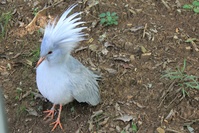 HENRI.13090Assidu
HENRI.13090Assidu
- Messages : 4245
Date d'inscription : 27/09/2010
Age : 79
Localisation : Aix-en-Provence
 Re: Contradusta lapillus Poppe, Tagaro & Groh, 2013 voir Contradusta walkeri walkeri
Re: Contradusta lapillus Poppe, Tagaro & Groh, 2013 voir Contradusta walkeri walkeri
Lun 8 Juil 2013 - 12:08
Je pense que je me suis trompé...... Quoique......... pourtant cela m'avait choqué.
Je connais bien le Cypraea walkeri f.lapillus.
Merci, et attendons d'autres avis car je ne crois pas avoir revé.
Je connais bien le Cypraea walkeri f.lapillus.
Merci, et attendons d'autres avis car je ne crois pas avoir revé.

_________________
L' ennui dans ce monde, c' est que les idiots sont sûrs d' eux et les gens sensés pleins de doutes.
 Bernard Clavé †Modérateur
Bernard Clavé †Modérateur
- Messages : 7265
Date d'inscription : 28/06/2011
Age : 82
Localisation : Gironde
 Re: Contradusta lapillus Poppe, Tagaro & Groh, 2013 voir Contradusta walkeri walkeri
Re: Contradusta lapillus Poppe, Tagaro & Groh, 2013 voir Contradusta walkeri walkeri
Lun 8 Juil 2013 - 16:21
C'est la Cypraea walkeri f. lapillus qui est devenue Cypraea lapillusHenri Luchesi a écrit:
Je connais bien le Cypraea walkeri f.lapillus.
Bernard
_________________
Je pense ce que je dis, je dis ce que je fais et je fais ce que je dis...... Et qu'importe le "Qu'en dira t'on".......



Nanard33
 Guy Bréchon †Accro
Guy Bréchon †Accro
- Messages : 323
Date d'inscription : 09/02/2012
Age : 71
Localisation : Six Fours les plages (83)
 Re: Contradusta lapillus Poppe, Tagaro & Groh, 2013 voir Contradusta walkeri walkeri
Re: Contradusta lapillus Poppe, Tagaro & Groh, 2013 voir Contradusta walkeri walkeri
Mer 10 Juil 2013 - 18:04
Il y a un article paru dans la revue "Vissaya" n° iV -1
D'autre part j'ai reçu ce mail reçu de Guido:
Désolé il est en anglais ... mais avis aux amateurs attention aux faux!
THE FAKE LAPILLUS CASE
The "Binabuy" is a particular good choice as symbol of this newsletter because some collectors now prefer the "fakes" when the the real thing is too expensive. Some dealers, especially suppliers from the Philippines, use the replacement "fake" in case they cannot get the real shell.
This was as such already centuries ago, when Linnaeus described the fake cowry "Cypraea amethystina" and it was as such in the golden time of shell collecting when the king of shell dealers of the 20th century, Gino Raybaudi, was trapped with the "teramachii splendida" in 1995. It is still so today. We got lured in by local dealers and our trust was shamefully misused. We acquired 10 faked Contradusta lapillus without knowing it. Fortunately, the real C. lapillus exists, and now over a hundred pieces have been found.


After a close examination, and as material slowly poured in, we decided to describe the cowry. While researching information, we stated that this cowry is found about everywhere in the Visaya's when one goes 100 m deep. Sheila P. Tagaro even photographed a specimen dredged in Panglao in 2004 during her assignment in the now famous and legendary "Panglao expedition 2004".
So, things went very well and Visaya appeared with the description of "Contradusta lapillus Poppe, Tagaro & Groh, 2013", in time for the Paris shell show. During that shell show, Felix Lorenz acquired about 30 pieces from a well-known French dealer also living in the Philippines. While scrutinizing his material, Felix came to the conclusion that the materials were fake C. walkeri. He tested out heating and could produce the same shells.
At the same time, shells appeared everywhere, especially also on a popular auction site. A telephone call to the Belgian collector learned me that he wanted to describe the new item: he could acquire several more, directly from Philippine dealers.
I was shocked and an investigation was highly needed. So, we called and interrogated many fishermen and middlemen. The truth became apparent very quickly: after our auction, local dealers often get the photographs of our auction shells from Europe and America with questions from collectors "to purchase" these items cheaper. A quite naïve action, as most of our auction pieces are difficult to find and even very often they are unique.
The son of a famous local dealer was immediately focused and went to the local "shell doctor" with pieces of walkeri which were then heated in "cooking oil", so the color turned pale and resembles the C. lapillus.

It took us a trip to Surigao to find this out. We also obtained there a dozen of C. lapillus which we now have in alcohol and of which some will be used for molecular research, also in order to see differences with C. walkeri.
According to Felix Lorenz, the correct genus should be "Ficadusta" and in the worst case the new name can be used for what is now called the classic Philippine walkeri (not the surabajensis).
Conchology, Inc. sold 4 of the fake cowries. They are replaced with genuine ones of course. The difference between the fakes and the real C. lapillus is hardly visible. Real lapillus are usually smaller than the fakes, usually a little more slender and usually the pattern typical for "surabajensis" is less visible. The color is most often more yellowish. In the batch of shells, which F. Lorenz returned to the French dealer, there were 10 genuine shells. This was confirmed to me by the fisherman. It may explain why some of his shells lighted up differently under UV. The few shells that I've seen on the auction site (only 5) were genuine. But this morning I met the "shell doctor" who got a truly big smile: faking shells is definitely not yet finished.
D'autre part j'ai reçu ce mail reçu de Guido:
Désolé il est en anglais ... mais avis aux amateurs attention aux faux!
THE FAKE LAPILLUS CASE
The "Binabuy" is a particular good choice as symbol of this newsletter because some collectors now prefer the "fakes" when the the real thing is too expensive. Some dealers, especially suppliers from the Philippines, use the replacement "fake" in case they cannot get the real shell.
This was as such already centuries ago, when Linnaeus described the fake cowry "Cypraea amethystina" and it was as such in the golden time of shell collecting when the king of shell dealers of the 20th century, Gino Raybaudi, was trapped with the "teramachii splendida" in 1995. It is still so today. We got lured in by local dealers and our trust was shamefully misused. We acquired 10 faked Contradusta lapillus without knowing it. Fortunately, the real C. lapillus exists, and now over a hundred pieces have been found.

"Contradusta lapillus Poppe, Tagaro & Groh, 2013". "The real one"

Freshly caught two days before this photograph, preserved in alcohol.
Things went as follows: our company sponsored some fisherman working deep waters offshore Surigao, by purchasing at a handsome price their catches. To our big surprise they fished a white cowry, close to - but different from - what is called Contradusta walkeri. We offered a few pieces to selected Cowry collectors and auctioned one shell, which went for about 400 Euro to a Belgian collector.After a close examination, and as material slowly poured in, we decided to describe the cowry. While researching information, we stated that this cowry is found about everywhere in the Visaya's when one goes 100 m deep. Sheila P. Tagaro even photographed a specimen dredged in Panglao in 2004 during her assignment in the now famous and legendary "Panglao expedition 2004".
So, things went very well and Visaya appeared with the description of "Contradusta lapillus Poppe, Tagaro & Groh, 2013", in time for the Paris shell show. During that shell show, Felix Lorenz acquired about 30 pieces from a well-known French dealer also living in the Philippines. While scrutinizing his material, Felix came to the conclusion that the materials were fake C. walkeri. He tested out heating and could produce the same shells.
At the same time, shells appeared everywhere, especially also on a popular auction site. A telephone call to the Belgian collector learned me that he wanted to describe the new item: he could acquire several more, directly from Philippine dealers.
I was shocked and an investigation was highly needed. So, we called and interrogated many fishermen and middlemen. The truth became apparent very quickly: after our auction, local dealers often get the photographs of our auction shells from Europe and America with questions from collectors "to purchase" these items cheaper. A quite naïve action, as most of our auction pieces are difficult to find and even very often they are unique.
The son of a famous local dealer was immediately focused and went to the local "shell doctor" with pieces of walkeri which were then heated in "cooking oil", so the color turned pale and resembles the C. lapillus.

A C. walkeri - cooked. The Fake "lapillus".
The French dealer acquired about 20 of these fakes, Conchology, 10 pieces. All offerings were made drop-wise of course. Many fakes went abroad. The shells offered by one dealer on this auction site are another story. One of the fisherman, paid indirectly by our company, took the shells out of the dredged material when there was no supervision. He then sold these to one of the dealers active on the auction site.It took us a trip to Surigao to find this out. We also obtained there a dozen of C. lapillus which we now have in alcohol and of which some will be used for molecular research, also in order to see differences with C. walkeri.
According to Felix Lorenz, the correct genus should be "Ficadusta" and in the worst case the new name can be used for what is now called the classic Philippine walkeri (not the surabajensis).
Conchology, Inc. sold 4 of the fake cowries. They are replaced with genuine ones of course. The difference between the fakes and the real C. lapillus is hardly visible. Real lapillus are usually smaller than the fakes, usually a little more slender and usually the pattern typical for "surabajensis" is less visible. The color is most often more yellowish. In the batch of shells, which F. Lorenz returned to the French dealer, there were 10 genuine shells. This was confirmed to me by the fisherman. It may explain why some of his shells lighted up differently under UV. The few shells that I've seen on the auction site (only 5) were genuine. But this morning I met the "shell doctor" who got a truly big smile: faking shells is definitely not yet finished.
_________________

 PLFAssidu
PLFAssidu
- Messages : 3037
Date d'inscription : 25/04/2010
Age : 69
Localisation : 1 rue de la Tuilerie 55500 Foucheres aux Bois
 Re: Contradusta lapillus Poppe, Tagaro & Groh, 2013 voir Contradusta walkeri walkeri
Re: Contradusta lapillus Poppe, Tagaro & Groh, 2013 voir Contradusta walkeri walkeri
Ven 19 Juil 2013 - 17:59


Contradusta lapillus -Poppe, Tagaro & Groh, 2013
Spécimen de 21 mm pris au filet entre 100 et 150 mètres de profondeur au large de Lipata, Surigao, Philippines
 PLFAssidu
PLFAssidu
- Messages : 3037
Date d'inscription : 25/04/2010
Age : 69
Localisation : 1 rue de la Tuilerie 55500 Foucheres aux Bois
 Re: Contradusta lapillus Poppe, Tagaro & Groh, 2013 voir Contradusta walkeri walkeri
Re: Contradusta lapillus Poppe, Tagaro & Groh, 2013 voir Contradusta walkeri walkeri
Ven 19 Juil 2013 - 18:13


- à gauche : Contradusta walkeri (Sowerby I, 1832) 25 mm
- à droite : Contradusta lapillus - Poppe, Tagaro & Groh, 2013 21 mm
L'intêret de cette photo et de montrer deux spécimens chalutés dans le même secteur entre 100 et 150 mètres au large de Lipata, Surigao, Philippines
On voit que Contradusta lapillus diffère de Contradusta walkeri par les interstices entre les dents columellaires qui sont non pigmentés
 Bernard Clavé †Modérateur
Bernard Clavé †Modérateur
- Messages : 7265
Date d'inscription : 28/06/2011
Age : 82
Localisation : Gironde
 Re: Contradusta lapillus Poppe, Tagaro & Groh, 2013 voir Contradusta walkeri walkeri
Re: Contradusta lapillus Poppe, Tagaro & Groh, 2013 voir Contradusta walkeri walkeri
Ven 19 Juil 2013 - 18:23
Très joli spécimen..... 

Bernard


Bernard
_________________
Je pense ce que je dis, je dis ce que je fais et je fais ce que je dis...... Et qu'importe le "Qu'en dira t'on".......



Nanard33
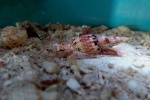 LETERRIER FranckExpert
LETERRIER FranckExpert- Messages : 3167
Date d'inscription : 27/02/2010
Age : 55
Localisation : Bourail Nouvelle-caledonie
 Re: Contradusta lapillus Poppe, Tagaro & Groh, 2013 voir Contradusta walkeri walkeri
Re: Contradusta lapillus Poppe, Tagaro & Groh, 2013 voir Contradusta walkeri walkeri
Ven 13 Déc 2013 - 8:39
Celle-ci draguée PI Lipata, Surigao-100~150m T:23mm




 jean marc jubertAssidu
jean marc jubertAssidu
- Messages : 3415
Date d'inscription : 08/11/2013
Age : 74
Localisation : var
 Re: Contradusta lapillus Poppe, Tagaro & Groh, 2013 voir Contradusta walkeri walkeri
Re: Contradusta lapillus Poppe, Tagaro & Groh, 2013 voir Contradusta walkeri walkeri
Ven 13 Déc 2013 - 10:39
belle coquille 

 Rhum3389Assidu
Rhum3389Assidu
- Messages : 4235
Date d'inscription : 27/01/2011
Age : 74
Localisation : 33133
 Re: Contradusta lapillus Poppe, Tagaro & Groh, 2013 voir Contradusta walkeri walkeri
Re: Contradusta lapillus Poppe, Tagaro & Groh, 2013 voir Contradusta walkeri walkeri
Ven 13 Déc 2013 - 20:46
Jolie acquisition Franck
Bernard
Bernard
 Rhum3389Assidu
Rhum3389Assidu
- Messages : 4235
Date d'inscription : 27/01/2011
Age : 74
Localisation : 33133
 Re: Contradusta lapillus Poppe, Tagaro & Groh, 2013 voir Contradusta walkeri walkeri
Re: Contradusta lapillus Poppe, Tagaro & Groh, 2013 voir Contradusta walkeri walkeri
Jeu 20 Fév 2014 - 15:05
Spécimen fraîchement pêché (pas nettoyé, je sais Nanard!) de 21 mm
draguée -150 m Lipata, Surigao, Philippines


draguée -150 m Lipata, Surigao, Philippines


 Re: Contradusta lapillus Poppe, Tagaro & Groh, 2013 voir Contradusta walkeri walkeri
Re: Contradusta lapillus Poppe, Tagaro & Groh, 2013 voir Contradusta walkeri walkeri
Ven 21 Fév 2014 - 1:47
Hello,
Je viens de passer quelques jours à Punta Engano et on m'a proposé des dizaines de lapillus. Etant incapable de distinguer le vrai du fake, je n'en ai pas achetée.
Celle de Rhum semble vraie...mais il est vrai aussi que les fausses sont habituellement garnies de "viande" a posteriori :)
Mon conseil : ne mettez pas tout votre budget dans une lapillus. C'est quand même l'un des plus beaux faits d'arme des shell doctors de ces dernières années !
Je viens de passer quelques jours à Punta Engano et on m'a proposé des dizaines de lapillus. Etant incapable de distinguer le vrai du fake, je n'en ai pas achetée.
Celle de Rhum semble vraie...mais il est vrai aussi que les fausses sont habituellement garnies de "viande" a posteriori :)
Mon conseil : ne mettez pas tout votre budget dans une lapillus. C'est quand même l'un des plus beaux faits d'arme des shell doctors de ces dernières années !
 Vinot WilliamPilier
Vinot WilliamPilier
- Messages : 8318
Date d'inscription : 28/01/2010
Age : 83
Localisation : Le Syndicat
 Re: Contradusta lapillus Poppe, Tagaro & Groh, 2013 voir Contradusta walkeri walkeri
Re: Contradusta lapillus Poppe, Tagaro & Groh, 2013 voir Contradusta walkeri walkeri
Ven 21 Fév 2014 - 8:09
Bonjour Bruno, bonne continuation dans tes prospections !!!
C'est vrai qu'ils sont marioles ces Philippins !!!!!
Merci pour le conseil, Bien cordialement.
C'est vrai qu'ils sont marioles ces Philippins !!!!!

Merci pour le conseil, Bien cordialement.
 Michel BargoinAdministrateur
Michel BargoinAdministrateur
- Messages : 12318
Date d'inscription : 01/09/2011
Age : 73
Localisation : Cergy - Val d'Oise
 Contradusta lapillus et ?
Contradusta lapillus et ?
Mar 9 Fév 2016 - 12:33
Bonjour,
Les deux de gauche sont des lapillus 21 et 23 mm et viennent de l'ile de Siargao aux Philippines - 150 m
Les deux de droite ??? même provenance pourraient en être aussi ?

Les deux de gauche sont des lapillus 21 et 23 mm et viennent de l'ile de Siargao aux Philippines - 150 m
Les deux de droite ??? même provenance pourraient en être aussi ?

_________________
«
 Contraria contrariis curantur. (Les contraires se guérissent par les contraires).»
Contraria contrariis curantur. (Les contraires se guérissent par les contraires).» Rhum3389Assidu
Rhum3389Assidu
- Messages : 4235
Date d'inscription : 27/01/2011
Age : 74
Localisation : 33133
 Re: Contradusta lapillus Poppe, Tagaro & Groh, 2013 voir Contradusta walkeri walkeri
Re: Contradusta lapillus Poppe, Tagaro & Groh, 2013 voir Contradusta walkeri walkeri
Mar 9 Fév 2016 - 19:03
J'aurais plutot dit les deux de droite en sont; celles de gauche??
 Michel BargoinAdministrateur
Michel BargoinAdministrateur
- Messages : 12318
Date d'inscription : 01/09/2011
Age : 73
Localisation : Cergy - Val d'Oise
 Re: Contradusta lapillus Poppe, Tagaro & Groh, 2013 voir Contradusta walkeri walkeri
Re: Contradusta lapillus Poppe, Tagaro & Groh, 2013 voir Contradusta walkeri walkeri
Mar 9 Fév 2016 - 19:18
Bernard merci,
On arrivera jamais à voter du même côté si on a pas la même gauche. Donc je prétends que les 1 & 2 (A gauche) sont des Lapillus
Je ne sais pas pour les 3 & 4

On arrivera jamais à voter du même côté si on a pas la même gauche. Donc je prétends que les 1 & 2 (A gauche) sont des Lapillus
Je ne sais pas pour les 3 & 4

_________________
«
 Contraria contrariis curantur. (Les contraires se guérissent par les contraires).»
Contraria contrariis curantur. (Les contraires se guérissent par les contraires).» Re: Contradusta lapillus Poppe, Tagaro & Groh, 2013 voir Contradusta walkeri walkeri
Re: Contradusta lapillus Poppe, Tagaro & Groh, 2013 voir Contradusta walkeri walkeri
Mar 9 Fév 2016 - 19:20
ok avec Rhum........... 2 sûre (3,4) et 2 (1,2) peut-être. Mais je n' en ai pas pour comparer.
_________________
''Point n'est besoin d' espérer pour entreprendre, ni de réussir pour persévérer''
Guillaume Ier d'Orange-Nassau.
Ce qui se conçoit bien s'énonce clairement - Et les mots pour le dire arrivent aisément.
 Michel BargoinAdministrateur
Michel BargoinAdministrateur
- Messages : 12318
Date d'inscription : 01/09/2011
Age : 73
Localisation : Cergy - Val d'Oise
 Re: Contradusta lapillus Poppe, Tagaro & Groh, 2013 voir Contradusta walkeri walkeri
Re: Contradusta lapillus Poppe, Tagaro & Groh, 2013 voir Contradusta walkeri walkeri
Mar 9 Fév 2016 - 19:27
Merci à tous les deux
J'ai acheté les deux de gauche comme étant des lapillus et les deux de droite en cadeau !
Vive ebay
J'ai acheté les deux de gauche comme étant des lapillus et les deux de droite en cadeau !
Vive ebay
_________________
«
 Contraria contrariis curantur. (Les contraires se guérissent par les contraires).»
Contraria contrariis curantur. (Les contraires se guérissent par les contraires).»- Contenu sponsorisé
Page 1 sur 2 • 1, 2 

Permission de ce forum:
Vous ne pouvez pas répondre aux sujets dans ce forum

